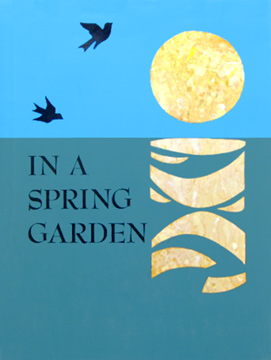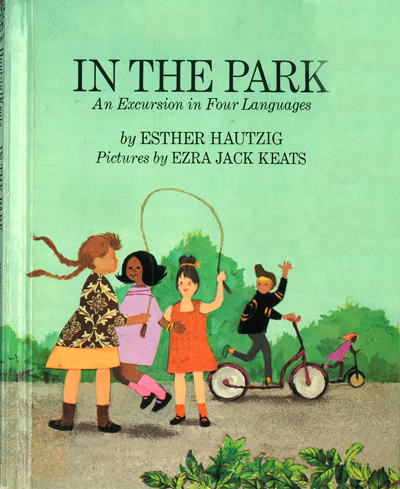
God is in the Mountain
Henry Holt (out of print), 1966
Keats surrounds short texts from different religious traditions with illustrations of simplicity and strength, to explore and to celebrate the universality of spiritual thought.

In a Spring Garden
Dial (now Scholastic), 1965
In this collection of haiku, edited by Richard Lewis, Keats’s artwork underscores the spare and beautiful words that describe the delicate balances of nature, such as this poem by Issa: “A red morning sky, For you, snail; Are you glad about it?

In the Park: An Excursion in Four Languages
Macmillan, 1968 (out of print)
Illustrated by Ezra Jack Keats and written by Esther Hautzig, In the Park is an inviting and innovative children’s book. On a beautiful, sunny day, families go to the park—in New York, Paris, Madrid and Moscow. The names of things they see, from bicycles to zoo animals, are given in English, French, Spanish and Russian. But the book is more than a vocabulary-builder. Ezra’s lively and colorful illustrations show a multicultural world shared by happy, active families. A similar book written today might have different cities, but the same question remains: If families can treat others with grace, perhaps nations can too?

Over in the Meadow
Four Winds Press (now Viking), 1971
An Appalachian counting rhyme evokes a lush meadow bustling with activity—one turtle digs, two fish swim and so on, up to 10 little fireflies that shine in the night. Keats’s vibrant illustrations perfectly complement this traditional verse, sure to delight the youngest reader.

The King’s Fountain
E.P. Dutton (out of print), 1971
Keats illustrates Lloyd Alexander’s dramatic fable with paintings of brilliant intensity. A king decides to create a wonderful palace fountain, which will divert the water supply from the city below. A poor man searches for someone who can persuade the king to change his mind. Finding no one willing, or better able, to reason with the king, he takes on the fearful task himself.

The Little Drummer Boy
Macmillan (now Viking), 1968
A poor child wants to see the baby Jesus, but has nothing to offer that would be worthy of royalty. Or so he thinks. Keats’s glowing illustrations capture the spirit of wonder in this well-loved Christmas song, as a young boy learns that a gift from the heart can be the best present of all.

The Naughty Boy
Viking, 1965
This mischievous poem first appeared in a letter written by a young John Keats, who called it “a song about myself.” It has been beloved by children ever since. Ezra Jack Keats has caught the poet’s whimsical spirit and kept his drawings simple to let us better imagine the wanderings of the naughty boy who “could not quiet be.”
And Long Remember, by Dorothy Canfield Fisher. McGraw Hill, 1959
Apple Orchard, by Irmengarde Eberle. H.Z. Walck, 1962
The Brave Riders, by Glenn Balch. Crowell, 1959
The Buffalo and the Bell, by Myra Scott Scovel. Friendship Press, 1963
A Change of Climate, by Jay Williams. Random House, 1956
Chester, by Eleanor Clymer. Dodd Mead, 1954
The Chinese Knew, by Tillie S. Pine and Joseph Levine. McGraw-Hill, 1958
Danny Dunn and the Anti-gravity Paint, by Jay Williams and Raymond Abrashkin. McGraw-Hill, 1957
Danny Dunn and the Homework Machine, by Jay Williams and Raymond Abrashkin. McGraw-Hill, 1958
Danny Dunn and the Weather Machine, by Jay Williams and Raymond Abrashkin, McGraw-Hill, 1959
Danny Dunn on a Desert Island, by Jay Williams and Raymond Abrashkin. Whittlesey House, 1957
Desmond’s First Case, by Herbert Best. Viking, 1961
The Egyptians Knew, by Tillie S. Pine and Joseph Levine. McGraw-Hill, 1964
The Eskimos Knew, by Tillie S. Pine and Joseph Levine. McGraw-Hill, 1962
Farm Dog, by David Malcolmson. Little, Brown, 1963
Felipe’s Long Journey: A Story of the Andes, by Edna Jennings Sorensen. Franklin Watts, 1961
A Flood in Still River, by Bianca Bradbury. Dial Books, 1961
The Flying Cow, by Ruth P. Collins. H.Z. Walck, 1963
The Gobbler Called, by Verne T. Davis. William Morrow, 1963
Grasses, by Irmengarde Eberle. H.Z. Walck, 1960
Hawaii: A Book to Begin On, by Juliet M. Swenson. Holt, Rinehart & Winston, 1963
How Animals Sleep: A Time for Sleep, by Millicent E. Selsam. Scholastic, 1962
How to be a Nature Detective, by Millicent E. Selsam. Scholastic, 1963 (reissued in 1973 as How to be an Animal Detective)
Indian Two Feet and His Horse, by Margaret Friskey. Scholastic, 1964
In the Night, by Paul Showers. Crowell, 1961
In the Park: An Excursion in Four Languages, by Esther R. Hautzig. Macmillan, 1968
The Indians Knew, by Tillie S. Pine. McGraw-Hill, 1957
Jim Can Swim, by Helen D. Olds. Knopf, 1963
Jubilant for Sure, by Elisabeth Hubbard Lansing. Crowell, 1954
Jumblies, by Edward Lear. Best In Children’s Books, Vol. 17; Doubleday, 1959
Krishna and the White Elephant, by Ruth Collins. H.Z. Walck, 1961
Little Hawk and the Free Horses, by Glenn Balch. Crowell, 1957
Mystery on the Isle of Skye, by Phyllis A. Whitney. Westminster, 1955
Night, compiled by Ezra Jack Keats, photographs by Beverly Hall. Atheneum, 1969
Nihal, by Eleanor A. Murphey. Crowell, 1960
Our Rice Village in Cambodia, by Ruth Tooze. Viking, 1963
Panoramas, edited by William S. Gray, Marion Monroe, A. Sterl Artley and May Hill Arbuthnot. Scott Foresman, 1957
The Peg-Legged Pirate of Sulu, by Cora Cheney. Knopf, 1960
Penny Tunes and Princesses, by Myron Levoy. Harper & Row, 1972
The Peterkin Papers, by Lucretia P. Hale. Doubleday, 1963
The Pilgrims Knew, by Tillie S. Pine and Joseph Levine. McGraw-Hill, 1957
The Rice Bowl Pet, by Patricia Miles Martin. Crowell, 1962
Song of the River, by Billy C. Clark. Crowell, 1957
Sounds We Hear, by Gerald S. Craig and Beatrice D. Hurley. Best in Children’s Books, Vol. 10; Doubleday, 1958
Speedy Digs Downside Up, by Maxine W. Kumin. G.P. Putnam’s Sons, 1964
Sure Thing for Shep, by Elisabeth Hubbard Lansing. Crowell, 1956

That First Easter, by Henry Denker. Crowell, 1959
Three Children of Chile, by Ella Huff Kepple. Friendship Press, 1961
Three Young Kings, by George Albee. Franklin Watts, 1956
Tia Maria’s Garden, by Ann Nolan Clark. Viking, 1963
The Time of the Wolves, by Verne T. Davis. William Morrow, 1962
The Tournament of the Lions, by Jay Williams. H.Z. Walck, 1960
Tres Casas, Tres Familias, by Edna Beiler. Friendship Press, 1964
Two Tickets to Freedom: The True Story of Ellen and William Craft, Fugitive Slaves, by Florence B. Freedman. Simon & Schuster, 1971
Wee Joseph, by William MacKellar. McGraw-Hill, 1957
What a Magnet Can Do, by Gerald S. Craig and Sara E. Baldwin. Best in Children’s Books, Vol. 1; Doubleday, 1957
What Eddie Brought Home, by Carolyn Haywood. Best in Children’s Books, Vol. 9; Doubleday, 1958
What Good Is a Tail? by Solveig P. Russell. Bobbs Merrill, 1962
Wonder Tales of Dogs and Cats, by Frances Carpenter. Doubleday, 1955
Your Own Aquarium, by Victor C. Smith, Barbara Henderson and W.R. Teeters. Best in Children’s Books, Vol. 4; Doubleday, 1957
Zoo, Where Are You? by Ann McGovern. Harper & Row, 1964
